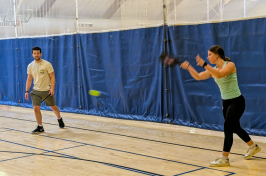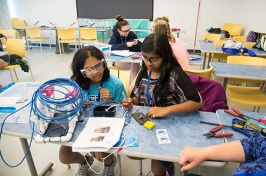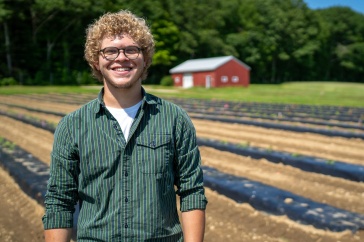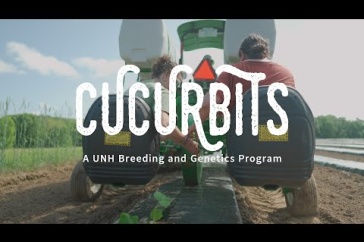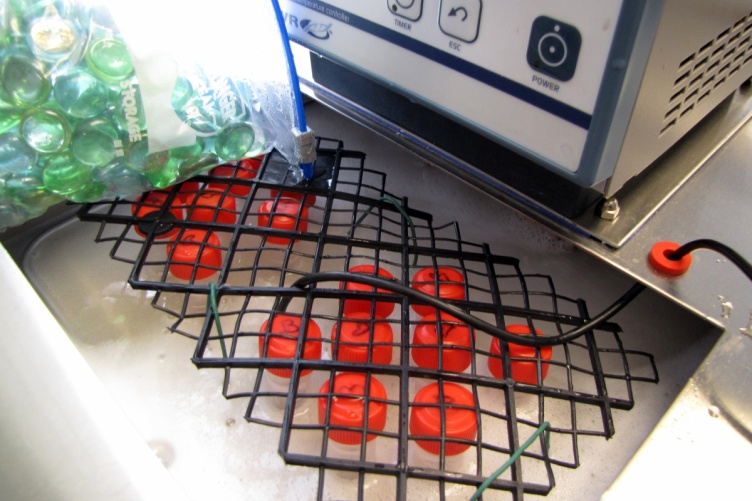
Root samples are placed in a glycol freeze to see how tolerant they are to extremely cold temperatures.
Nearly every gardener knows that one of the best strategies in choosing plants is to consult the USDA Plant Hardiness Zone Map, which identifies plants based on how tolerant the plant shoots are to cold temperatures. But plant roots are another story, and they often are less tolerant of sub-freezing temperatures than the shoots of the same plant. For businesses that grow nursery stock in containers, protecting container-grown plants during winter leads to increased labor costs and can cause high losses due to physical damage.
Research funded by the NH Agricultural Experiment Station (NHAES) through the USDA National Institute of Food and Agriculture aims to reduce nursery costs and losses by providing more comprehensive information on which container-grown shrubs can be left outside during winter, which shrubs need to be covered, and which shrubs should be placed in a heated enclosure.

The goal of the research is to support local production of nursery products, which saves energy, encourages use of native and adapted plants, and supports the local economy. “This study will lead to the continued development of easier, more reliable and more economical production methods, making nursery stock production a more profitable enterprise for Northern growers,” said NHAES researcher Cathy Neal, an extension specialist in landscape horticulture.
New Hampshire’s nursery and greenhouse sector is among its top agricultural industries, with annual sales of nearly $50 million, according to the 2012 U.S. Census of Agriculture. A multimillion dollar industry that is part of this sector, container-grown nursery crop production is on the increase in the Granite State since container-grown plants are more easily harvested, handled, and sold to consumers than traditional balled-and-burlapped stock.
Neal has been conducting experiments on root cold tolerance and plant performance in Northern nursery production systems for three years. In experiments at the Woodman Horticultural Research Farm and the UNH Macfarlane Research Greenhouses, both experiment station facilities, she has been trying to better understand root cold tolerance and how it is affected by cultural and environmental factors in container-grown plants.
“When plants are growing in the ground, the soil acts as a buffer to cold temperatures. The roots haven’t evolved to tolerate extreme cold. When we put those plants in containers, the roots get exposed to colder temperatures,” Neal explained. “It’s a lot of work moving container plants in and out of storage facilities, and there is a lot of loss from structural damage as a result of moving them to protected storage areas.”
She also is looking at the lasting impact of production systems on root structure, tree health and longevity, and whether root pruning at transplanting is effective at correcting defects. Growing plants in containers alters the way shrub and tree roots grow, which may have long-term effects after the plant is transplanted.
Jeffrey Meulenbroek, owner of Studley Flower Gardens in Rochester, is familiar with Neal’s research. “There is a lot of labor involved in overwintering nursery stock, and damage to the shrubs can occur from handling the plant material and rodents as well as from cold damage. As a small grower and retailer, any amount of shrink is a problem. However, it is particularly frustrating with higher-value plants like nursery stock. When I buy and grow a tree or shrub for a season, I hope to sell at a premium the following season after it is overwintered. However, when shrubs die in the process, I have a lot of lost labor and inputs beyond the original cost of the shrub,” Meulenbroek said.
“If it is determined that some species of containerized shrubs could be left outside safely through winters in New Hampshire, that would certainly save me labor and prevent damage from handling the nursery stock when storing it for winter and again when taking the nursery stock out again for sale in the spring,” he said.
Meulenbroek said Neal’s NHAES research could be valuable to the nursery industry, particularly if it supports more New Hampshire nursery production. “I would prefer to buy from more local growers of nursery stock, ensuring that shrubs are best suited to this area,” he said.
Founded in 1887, the NH Agricultural Experiment Station at theUNH College of Life Sciences and Agriculture is UNH’s original research center and an elemental component of New Hampshire's land-grant university heritage and mission. We steward federal and state funding to provide unbiased and objective research concerning diverse aspects of sustainable agriculture and foods, aquaculture, forest management, and related wildlife, natural resources and rural community topics. We maintain the Woodman and Kingman agronomy and horticultural farms, the Macfarlane Greenhouses, the Fairchild Dairy Teaching and Research Center, and the Organic Dairy Research Farm. Additional properties also provide forage, forests and woodlands in direct support to research, teaching, and outreach.
-
Written By:
Lori Tyler Gula, PhD | NH Agricultural Experiment Station | lori.gula@unh.edu | 603-862-1452



























